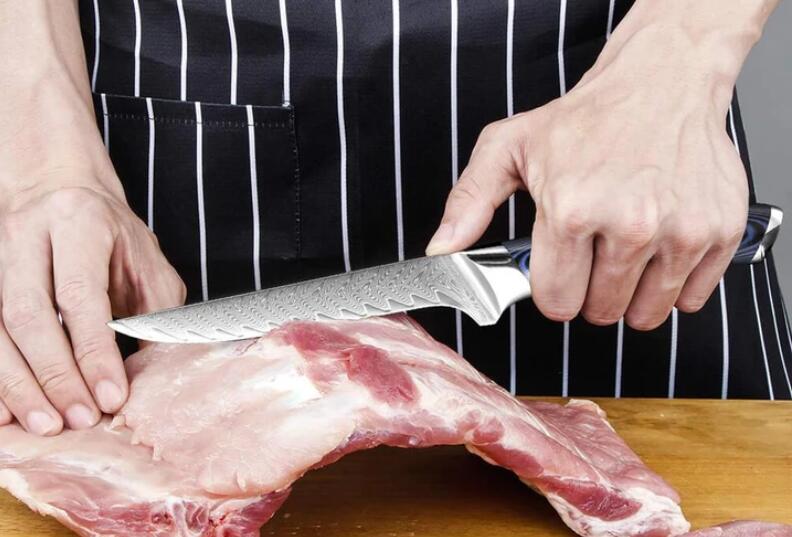When in terms of kitchen knives, 85% of people would think about Japanese kitchen knives which have a fantastic reputation. If you've ever used professional knife blade from Japan, then you knew quality. Japan has always been famous for making blades, whether it is samurai swords or kitchen knives.

We also collect feedback of our customers about how they think about kitchen knives, here’s one we’d like to share with you.
"In addition to the quality of steel; they just work well! Here’s one I bought for my chef son from layered Damascus steel with a VG-10 core for a cutting edge. Pointed-shape knife tip and colored stabilized wood handle. If you zoom in on the blade you can see the outer layers and the VG-10 core. The Damascus layers fold around the core like a taco shell and protect the thin cutting edge from damage and support it." ——Myles Lindsey, one of customer.
As we can see the reputation of Japanese kitchen knife is really very good. If you are a beginner to Japanese knives, you may be wondering what is so special about them, what makes Japanese knives so attractive and different, and why should I invest in one? Don‘t worry, we are here to share our research result with you.
The reasons of why Japanese knives are popular
1. The craftsman's spirit of detail-oriented
Craftsmen pay great attention to details, such as the point of balance, weight distribution, blade materials, handle materials, maintenance, ease of sharpening, type of steel for intended knife use, handle design, even often tweak the level of hardness to the optimum range depending on the knife’s intended use. put it in a more detailed example:
The curve of the knife is carefully controlled depending on intended knife use
the grind is often just convex enough so the knife is thin behind the edge but still reasonably sturdy, at the same tim, it offers good food release with less food sticking on the blade, etc.
2. Respect for the craftsman spirit
For some people, they don’t care about the knife maker, kitchen knives to them just consider to be cutting tools. But, there are some people, they adore the passion and dedication of the man who made it. They think craftsmen have some personality often comes out in their work. So, as a knives user, not only you should master knife cutting skills but also should enhance the cooking experience. Good Japanese kitchen knives make me appreciate the beauty of what I have in my hand and motivates me to do my best with the ingredients, just as the knifemaker poured his heart into crafting the blade I am using to do just that. they respect this kind of spirit, so they are willing to use and maintain the Japanese kitchen knives with the same seriousness attitudes as the craftsman spirit.
3. Use highest quality steel
Japanese knives are made of the highest quality steel to ensure durability, sharpness, and strength. Generally, Japanese knives are thinner, harder, and sharper. A Japanese kitchen knife has thinner, sharper bevels made of harder steel that keep their edge for longer.
Knife makers have challenged themselves to make knives that have excellent cutting performance and are extremely practical. Consequently, it is most important for the knife maker to choose the right steel.
When it comes to steel, Knifemakers in Japan have a wide range of choice. some companies have long supported traditional knife industries with carbon steels rated "best in class", and some other companies like to use modern steel such as VG10, AUS-10 and cladding with nickel Damascus.
4. Aesthetics elegance
So the attraction of Japanese knives doesn’t just because it's functionality, but also in its aesthetics pleasing. Centuries of experience in knife making resulting in excellent performance knives in its sharpness, strength, precision, and beauty.
In addition, Japanese knives feature attractive cylindrical, octagonal, or D-shaped handles with different knife handle materials, such as G10, markata, pakka wood, sandalwood, stabilized wood, etc.
All of these add elegance to the knife to make cooking preparation a pleasure rather than a chore.
Japanese vs. European Kitchen Knives
Japanese knives tend to be lighter weight and more elegant than European knives, more suitable for more precise cuts. We’ll talk about it in following factors:
1. Hardness
Traditionally, Japanese knives contain more carbon than German knives which make it harder but less durable. But, with the development of technology, Japanese knives combines hard steel and soft steel to make knives hold an edge longer and do not need to be sharpened as often. Japanese knives require far less sharpening and maintenance than European knives.
In addition, typically, Japanese knife is sharper than the German knife. German knife has a hardness rating of HRC 52 – HRC 56 while Japanese knife has a hardness ranging from HRC 58 – 65.
2. Weight
Japanese knives are lighter than European knives. In one hand, European knives usually have a finger guard on the bolster to add extra weight, while the bolster on Japanese knives is just an extension of the blade to make it more balanced for fine and complex cuts.
In another hand, from blade to handle, German knives are crafted totally from steel, while Japanese knives taper the steel inside of a handle, resulting in a lighter weight and more flexible control.
3. Angle of blade
Japanese blades are usually thinner than Europeans knives. Japanese knives have an edge-angle of around 15 degrees, while European knives have edge-angles of around 20 degrees. thus the Japanese blade is straighter for more precise cutting, especially in slicing.
The Best Japanese Kitchen Knives by Type
We respect each country's food culture and cooking style, so, it's difficult to recommend an ‘essential knife set, Fortunately, high-quality Japanese knives are available in a number of choices, let's introduce some popular Japanese knife type for you.
1. Santoku knife
In Japan, the most commonly used home cooking knife is the Santoku knife. which called either “three-purpose” or “three virtues” in English, it means it is well good for cutting meat, fish, and vegetables. The Santoku is a more popular multi-purpose kitchen knife for home cooks than chef knives.
Our recommendation for Santoku knives: Letcase Japanese Damascus steel santoku knife.

This Letcase Santoku knife is a versatile knife for your kitchen, suitable for slicing, dicing, chopping, and mincing fruits, vegetables, fish, and boneless meat. The three-layer construction offers sharpness, edge retention, and durability. it's made 67 layers Damascus steel, which offers a razor-sharp blade while adds aesthetic elegance Damascus pattern on the blade which can eliminate friction and sticking.
The G10 handle is ergonomically designed to offer great grip, and the full tang increases balance, making it a perfect blade for any level of chef.
2. Chef knife
Chef knife is another popular kitchen knife in Japan.
A chef knife has a slightly curved blade allowing you to rock the knife back and forth as you cut, even though it is often used in Japanese cuisine, it's also suitable for preparing Western food. to some degree, this knife can replace any chef’s knife in Europe. The sharp tip is perfect for precision work, especially slicing meat and vegetables.
Our recommendation for chef knives: Hand forged Damascus steel chef knife with sheath.

This hand-forged Damascus chef knife is narrower than other chef knives, makes it more flexible. as you know, A flexible knife is vital in any chef’s kitchen. It's also use 67 layers Damascus steel, which was hammered and forged for strength and eliminating friction, reducing sticking on the blade.
The blue G10 handle is ergonomic for comfort and unique for special.
in addition, it comes with a knife sheath to protect the knife in excellent condition and reduce the need for sharpening.
3. Kiritsuke knife
Kiritsuke knife is one of the traditional Japanese knives too, which is often used for slicing sashimi or as a multi-functional knife. With an angled tip, the Kiritsuke knife is often discovered in restaurant use.
Our recommendation for Kiritsuke knife: Letcase 8 inch vg10 Damascus steel kiritsuke knife.

This Damascus Kiritsuke knife looks very beautiful with its colorful handle, it's not an exaggeration to say it is a work of art. Except for its beauty, it's also feel good in your hand.
The traditional convex-grind Damascus steel blade has outstanding sharpness with amazing durability. It is easy to sharpen this knife with fine whetstone when it turns blunt. It's a perfect knife for thin slicing in any kitchen.
4. Meat cleaver
As the name implied, the meat cleaver knife is originally designed for cutting through bone or cartilage. Of course, we don't recommend you cut directly on the hard bone often.
Our recommendation for butcher knives: High-carbon steel hand forged cleaver knife.

This hand-made butcher knife Select premium high-carbon steel, going through repeated forging and folding to create high hardness and sharp blade, with it’s heavy weight, it’s for cutting through bone or cartilage.
The ebony solid wood, copper ring reinforcement, not easy to deform, non-slip.


0 comments